
A train is a series of connected vehicles that run along a railway track and transport people or freight. Trains are typically pulled or pushed by locomotives or railcars, though some are self-propelled, such as multiple units. Passengers and cargo are carried in railroad cars, also known as wagons. Trains are designed to a certain gauge, or distance between rails. Most trains operate on steel tracks with steel wheels, the low friction of which makes them more efficient than other forms of transport.

A conductor or guard is a train crew member responsible for operational and safety duties that do not involve actual operation of the train/locomotive. The conductor title is most common in North American railway operations, but the role is common worldwide under various job titles. In Commonwealth English, a conductor is also known as guard or train manager.

A caboose is a crewed North American railroad car coupled at the end of a freight train. Cabooses provide shelter for crew at the end of a train, who were formerly required in switching and shunting, keeping a lookout for load shifting, damage to equipment and cargo, and overheating axles.
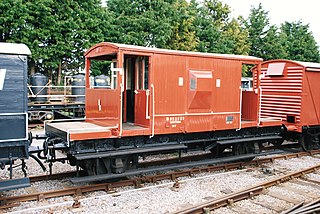
Brake van and guard's van are terms used mainly in the UK, Ireland, Australia and India for a railway vehicle equipped with a hand brake which can be applied by the guard. The equivalent North American term is caboose, but a British brake van and a caboose are very different in appearance, because the former usually has only four wheels, while the latter usually has bogies. German railways employed brakeman's cabins combined into other cars.
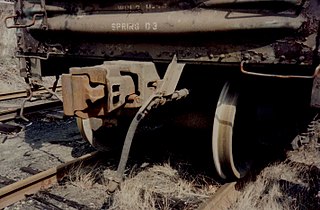
The Safety Appliance Act is a United States federal law that made air brakes and automatic couplers mandatory on all trains in the United States. It was enacted on March 2, 1893, and took effect in 1900, after a seven-year grace period. The act is credited with a sharp drop in accidents on American railroads in the early 20th century.
Rail transport terms are a form of technical terminology applied to railways. Although many terms are uniform across different nations and companies, they are by no means universal, with differences often originating from parallel development of rail transport systems in different parts of the world, and in the national origins of the engineers and managers who built the inaugural rail infrastructure. An example is the term railroad, used in North America, and railway, generally used in English-speaking countries outside North America and by the International Union of Railways. In English-speaking countries outside the United Kingdom, a mixture of US and UK terms may exist.
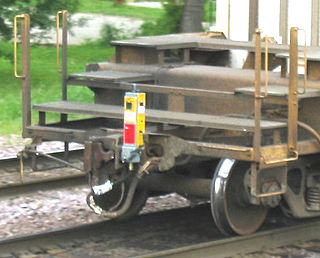
The end of train device (ETD), sometimes referred to as an EOT, flashing rear-end device (FRED) or sense and braking unit (SBU) is an electronic device mounted on the end of freight trains in replacement of a caboose. They are divided into three categories: "dumb" units, which only provide a visible indication of the rear of the train with a flashing red taillight; "average intelligence" units with a brake pipe pressure gauge; and "smart" units, which send back data to the crew in the locomotive via radio-based telemetry. They originated in North America, and are also used elsewhere in the world, where they may include complete End of Train Air System (ETAS) or Sense and Brake Unit (SBU) devices.

A railway brake is a type of brake used on the cars of railway trains to enable deceleration, control acceleration (downhill) or to keep them immobile when parked. While the basic principle is similar to that on road vehicle usage, operational features are more complex because of the need to control multiple linked carriages and to be effective on vehicles left without a prime mover. Clasp brakes are one type of brakes historically used on trains.
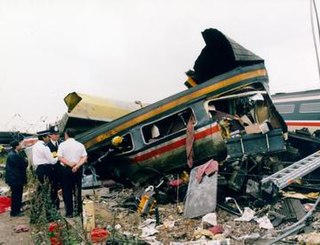
The Southall rail crash occurred on 19 September 1997, on the Great Western Main Line at Southall, West London. An InterCity 125 high speed passenger train (HST) failed to slow down in response to warning signals and collided with a freight train crossing its path, causing seven deaths and 139 injuries.
On 8 February 1986, twenty-three people were killed in a collision between a Canadian National Railway freight train and a Via Rail passenger train called the Super Continental, including the engine crews of both trains. It was the deadliest rail disaster in Canada since the Dugald accident of 1947, which had thirty-one fatalities, and was not surpassed until the Lac-Mégantic rail disaster in 2013, which resulted in 47 deaths.

A bank engine, banking engine, helper engine or pusher engine is a railway locomotive that temporarily assists a train that requires additional power or traction to climb a gradient. Helpers/bankers are most commonly found in mountain divisions, where the ruling grade may demand the use of substantially greater motive power than that required for other grades within the division.

Rail freight transport is the use of railways and trains to transport cargo as opposed to human passengers.
This article contains a list of terms, jargon, and slang used to varying degrees by railfans and railroad employees in the United States and Canada. Although not exhaustive, many of the entries in this list appear from time to time in specialist, rail-related publications. Inclusion of a term in this list does not necessarily imply its universal adoption by all railfans and railroad employees, and there may be significant regional variation in usage.
Electronically controlled pneumatic brakes are a type of railway braking systems.

A running board or footboard is a narrow step fitted under the side doors of a tram, car, or truck. It aids entry, especially into high vehicles, and is typical of vintage trams and cars, which had much higher ground clearances than today's vehicles. It is also used as a fashion statement on vehicles that would not otherwise require it. The origin of the name running board is obscure; the first running boards predate automobiles and were installed on carriages as early as the 17th century.
This article lists some of the terminology used at present and in the past by railway employees, railway enthusiasts and railway historians in Australia. Many appear from time to time in specialist, rail-related publications. Significant regional variations exist, indicated by abbreviations of the state or railway.
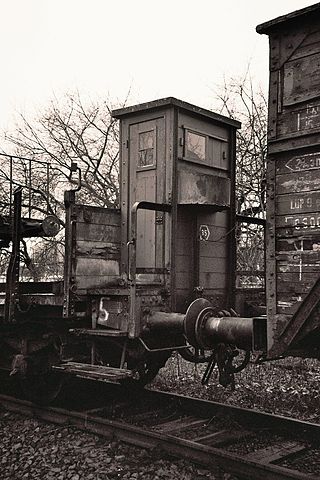
A brakeman's cabin or brakeman's caboose (US) was a small one-man compartment at one end of a railway wagon to provide shelter for the brakeman from the weather and in which equipment for manually operating the wagon brake was located. They were built in the days before continuous braking was available and the locomotive brake needed to be augmented by brakemen applying the wagon brakes individually.
An accident occurred on the four-track mainline of the New York Central Railroad at 10:02 P.M. on March 27, 1953, 2.4 miles east of Conneaut, Ohio. It began when an improperly secured load of pipe broke loose from a gondola car on an eastbound freight train, damaging the westbound passenger track. A passing westbound freight crew notified the first train and stopped to assess what had happened, but a fast westbound passenger train could not stop and was derailed by the damaged track, colliding with the adjacent westbound freight. Finally, an eastbound fast passenger train struck the derailed equipment from the first two trains. There were 21 deaths and 49 people were injured. This accident holds the record for the most trains involved in a single accident.

The Brakemen's Brotherhood was an early American railroad brotherhood established in 1873. The group was a secret society organizing railroad brakemen into a fraternal benefit society and trade union. The organization was largely destroyed in the aftermath of the failed Great Railroad Strike of 1877, although it continued to maintain an existence nationwide through the 1880s.

The Harvey train collision took place on October 12, 1979, when the Shawnee train operated by Amtrak between Carbondale and Chicago Union Station crashed into a parked Illinois Central Gulf freight train, leading to the death of two crew members.
















